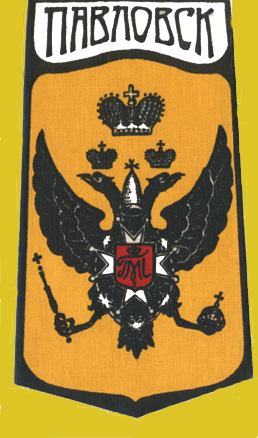|
This was the last of the great palaces
constructed outside St. Petersburg. It began as a small hunting lodge. In 1777
Catherine II gave the estate property to her son, Paul Petrovich on the birth
of his son, Alexander. Paul was a notorious martinet and military-minded ruler,
but also highly gifted with artistic talent. He quickly changed the estate into
a magnificent palace. Among the artists he hired were Charles Cameron, Pietro
Gonzaga, Vincenzo Brenna, Carlo Rossi and Giacomo Quarenghi. Cameron was the
first up, from 1782 - 1796. He designed a country residence with both Russian
country and Italian Palladian styles. The main block has three stories and is
decorated with columned porticos. Its Palladian dome is visible from afar.
There are semicircular side wings linked to it by galleries. Cameron liked
classical style, as is seen in his work at the Catherine Palace. Here he
decorated the rooms in neo-classical style. But today only five of the
ground-floor rooms remain as he designed them. It was Grand Dutchess Maria
Fyodorovna who brought Vincenzo Brenna on board to make the interior more
elaborate to suit her taste. Brenna designed the magnificent Picture gallery we
see today loaded with fine paintings. He added neo-Egyptian and Roman
decorations but also provided enough military materials to suit Paul as well.
Paul and Maria personally saw to most of the interior furnishings during their
grand tour to western Europe, meeting and hiring master craftsmen for future
work. Maria especially filled the palace with porcelain from all over the
world.
When Paul became Emperor in 1796 he had the funds to expand the construction.
He added another story to the side wings and built the chapel. After Paul's
death Maria Fyodorovna employed Giacomo Quarenghi to redecorate the ground
floor private rooms in an effort to remove sad memories of her murdered
husband. She lived most of each year here and lavished her artistic taste on
its embellishment. After a fire in 1803 Andrei Voronikhin redid these rooms
once again. Voronikhin was a serf belonging to Count Stroganov, who provided
him with a fine education in architecture and engineering before freeing him.
He also redid the exquisite Lantern Study for Maria Fyodorovna. This was
Voronikhin's masterpiece. In 1820's Rossi designed the library.
During World War II the Germans occupied the palace and it burned. Restoration
work began immediately after the war. We now have new photography from visit in
2005.
|
|
 |
Northern wing of the Great Palace at
Pavlovsk.
|
|
 |
Central section of the Great Palace at
Pavlovsk
|
|
 |
Statue of Emperor Paul I in his favorite
Prussian military uniform in the central courtyard of the Pavlovsk Palace.
|
|
 |
Ceiling in the Egyptian Vestibule on the
ground floor entrance to the Pavlovsk Palace.
|
|
 |
Egyptian Vestibule room on ground floor of
Pavlovsk Palace. This was redesigned by Voronikhin with Egyptian statues and
zodiac signs in the medallions.
|
|
 |
Egyptian Vestibule room on ground floor of
Pavlovsk Palace. With staircase through the archway.
|
|
 |
Ceiling in the State vestibule on the first
floor designed by Brenna for Paul I with military symbols.
|
|
 |
Upper level of the Italian Hall.
|
|
 |
An alcove in the Italian Hall.
|
|
 |
Ceiling in the small study.
|
|
 |
Corridor
|
|
 |
Mirror, clock and mantelpiece
|
|
 |
Paul's small study - model of a temple made
in ivory, amber and gilded bronze by Maria herself.
|
|
 |
Gobelin tapestry in the Gobelin Room -
presented by French King Louis XIV.
|
|
 |
Hall of War in Paul's suite of rooms.
|
|
 |
Grecian Hall designed by Cameron to look like
a Greek temple. The green marble columns offset the white artificial marble
walls. This central hall is between Paul's and Maria's suites. The walls are
all white, but unfortunately the underexposure results in the off color while
the closest column is green but the overexposure from the flash makes it look
white and bluish..
|
|
 |
Another view of the Grecian Hall. The
fireplaces were moved here from thee Engineer Palace after Paul's death. The
walls are white but unfortunately the underexposure results in their being off
color..
|
|
 |
Chair and table designed for Maria by
Voronikhin in her library. He introduced the neo-Egyptian motif.
|
|
 |
Tapestry in Maria's suite.
|
|
 |
Maria's boudoir.
|
|
 |
Canopy of the state bed in State Bedroom -
not the bed actually used by Maria, which is in her private bedroom on the
floor below.
|
|
 |
Fireplace in Maria's dressing room.
|
|
 |
Painting
|
|
 |
Picture gallery designed by Brenna to house
Paul's and Maria's art collection acquired during their grand tour of Western
Europe.
|
|
 |
The State Dining Room (originally throne
room) designed by Brenna in 1797.
|
|
 |
Part of the 606 piece dinner service created
by the St. Petersburg porcelain factory for Paul and Maria.
|
|
 |
The Hall of Knights.
|
|
 |
Chapel dedicated to Saints Peter and Paul
built into the Pavlovsk palace by Paul I. Note the western decoration and lack
of icons. This photo taken from the balcony.
|
|
 |
Typical ornate door.
|
|
 |
One of the many huge urns located throughout
the palace.
|
|
 |
The general study on the ground floor in the
family's private quarters. Portraits of Paul and all the family are shown here.
|
|
 |
The family private dining room on the ground
floor directly below the Grecian room. The room was designed by Cameron.
|
|
 |
A ballroom in the family private quarters on
the ground floor. The room was designed by Cameron.
|
|


